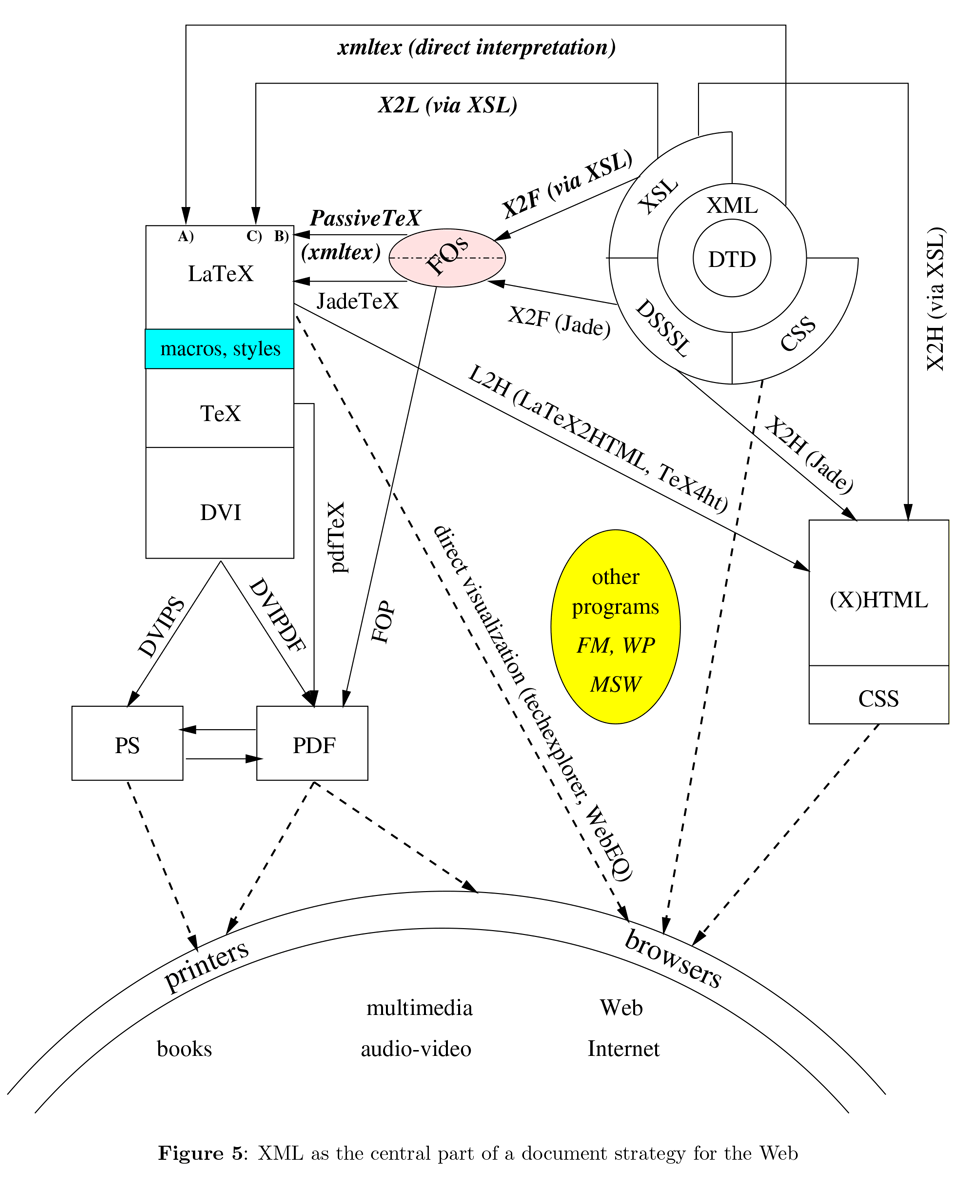Bridging the Gaps
Between XML and TEX
What is TeX?
- macro-based programming language by Donald E. Knuth
- LaTeX: macro package for TeX by Leslie Lamport
- typesetting system, popular in academia
Anatomy of a LaTeX Document
\documentclass{article} % preamble: document class
\usepackage[british]{babel} % preamble: package declaration
\title{my Markup UK paper} % global parameters
\author{Martin Kraetke}
\date{\today}
\begin{document} % document body start
\maketitle
\section{Introduction}
This is a paragraph with \textit{italicized text}.
\end{document} % document body endThe Gaps between XML and TeX
The Gaps between XML and TeX
- curly braces instead of angle brackets
- special characters:
& % $ # _ { } ~ ^ \ - preamble and document body
Textmode and Mathmode
\documentclass{article}
\begin{document}
text mode: \textsuperscript{superscript}
math mode: $^{superscript}$
\end{document}Tables
\documentclass{article}
\begin{document}
\begin{table}
\begin{tabular}{|l|c|r|} \hline
a1 & a2 & a3 \\ \hline
b1 & b2 & b3 \\ \hline
c1 & c2 & c3 \\ \hline
\end{tabular}
\end{table}
\end{document}
Tables: Multirow and Multicolumn
\documentclass{article}
\usepackage{multirow}
\begin{document}
\begin{table}
\begin{tabular}{|l|c|r|} \hline
a1 & \multicolumn{2}{|c|}{a2} \\ \hline
b1 & b2 & \multirow{2}{*}{b2} \\ \cline{1-2}
c1 & c2 \\ \hline
\end{tabular}
\end{table}
\end{document}TeX engines: Unicode support
- pdflatex ☐
- xetex ☑
- luatex ☑
Packages with overlapping functionality
- default:
\underline{…} - soul:
\ul{…} - ulem:
\uline{…}
Custom macros
\newcommand{\name}{definition}
\newenvironment{name}[num][default]{before}{after}Methods to convert XML to TeX
1. xmltex
1. xmltex*
- non-validating XML parser implemented in TeX by David Carlisle
- can associate TeX code with XML elements, attributes, processing instructions, and entities
1. xmltex - TeX file
\def\xmlfile{doc.xml} % xml file
\input xmltex.tex % loads xmltex1. xmltex - catalogue
\NAMESPACE{http://www.tei-c.org/ns/1.0}{tei.xmt}1. xmltex - mapping
\XMLelement{TEI}
{} % attributes
{\documentclass{article} % start of element
\begin{document}
{\end{document}} % end of element1. xmltex
- lightweight and somehow declarative
- nested structures require programming
- no XML query language (just names)
- error reporting virtually non-existent
2. PassiveTeX
2. PassiveTeX*
- by Michel Goossens, Sebastian Rahtz
- xmltex configuration for
XSL Formatting Objects (XSL-FO) - TeX acts as FO Formatters

2. PassiveTeX
\XMLelement{fo:root}
{}
{\documentclass{article}
\usepackage{fotex}
\begin{document}
\pagestyle{empty}
\FOSetHyphenation
%\ignorewhitespace
}
{\end{document}}2. PassiveTeX
- FO and xmltex not easy to debug
- experimental approach, rarely adopted
- very hard to configure
3. Pandoc
3. Pandoc*
- „universal“ markup converter
- supports XML (DocBook, JATS) and
LaTeX among other formats
3. Pandoc – DocBook example
<?xml version="1.0" encoding="UTF-8"?>
<article xmlns="http://docbook.org/ns/docbook" version="5.0">
<title>my Title</title>
<sect1>
<title>Random Section Title</title>
<para>This is a para and this is
<emphasis role="bold">bold</emphasis>
</para>
</sect1>
</article>3. Pandoc – TeX output
\section{Random Section Title}
This is a para and this is \textbf{bold}3. Pandoc
- XML input restricted to DocBook and JATS
- no configuration, you can program filters with Lua
- MathML not well supported
4. XSLT
4. XSLT
- flexible with XPath, regular expressions, grouping etc.
- <xsl:output method="text"/> for TeX output
- associate templates with TeX instructions
4. XSLT
<?xml version="1.0" encoding="UTF-8"?>
<xsl:stylesheet xmlns:xsl="http://www.w3.org/1999/XSL/Transform"
xpath-default-namespace="http://www.tei-c.org/ns/1.0"
version="3.0">
<xsl:output method="text"/>
<xsl:template match="TEI">
<xsl:text>\documentclass{article}
</xsl:text>
<xsl:text>\begin{document}
</xsl:text>
<xsl:apply-templates select="* except teiHeader"/>
<xsl:text>\end{document}</xsl:text>
</xsl:template>
<xsl:template match="p">
<xsl:apply-templates/>
<xsl:text>

</xsl:text>
</xsl:template>
</xsl:stylesheet>4. XSLT
- very powerful but also not a very declarative approach
- reusable code with imports
- Problem when source XML vocabulary changes
- implementing tables, math, various packages is complex
An alternative approach: xml2tex
xml2tex*
- module of le-tex transpect framework
- based on XProc/XSLT
- declarative XML configuration
- modules for MathML, tables
xml2tex - MathML conversion
- mml-normalize: MathML normalization
- mml2tex: MathML→TeX
mml2tex - MathML example
xml2tex - table conversion
- input: CALS and HTML tables (HTML→CALS)
- output: tabularx or htmltabs
Table normalization by Andrew J. Welch
+-----------+-----------+ +-----+-----+-----+-----+ | a | b | | a | a | b | b | | +-----+-----+ +-----+-----+-----+-----+ | | c | d | | a | a | c | d | +-----------+-----+ | ==> +-----+-----+-----+-----+ | e | | | e | e | e | d | +-----+-----+-----+ | +-----+-----+-----+-----+ | f | g | h | | | f | g | h | d | +-----+-----+-----+-----+ +-----+-----+-----+-----+
mml2tex - tables example
xml2tex - configuration
<ns/>declare namespaces<import/>import other xml2tex-configs
xml2tex - configuration (document structure)
<preamble/>doc class, packages, parameters etc.<front/>frontmatter<back/>backmatter
xml2tex - configuration (text body)
<template/>associates XML nodes with TeX<regex/>associates regular expressions with TeX<charmap/>character map
xml2tex - configuration
<template context="dbk:section">
<rule break-after="2" name="section" type="cmd">
<param/>
</rule>
</template>@name→ TeX name@type = "cmd"|"env"→ command or environment<param>→ {parameter}<option>→ [options]<text>→ regular text
xml2tex - Regex
<regex regex="(\d{1,2})\.(\d{1,2})\.(\d{4})">
<rule name="mydate" type="cmd">
<param select="regex-group(1)"/>
<param select="regex-group(2)"/>
<param select="regex-group(3)"/>
</rule>
</regex>xml2tex - Character maps
<charmap ignore-imported-charmaps="false">
<!--= Uppercase Gamma -->
<char character="Γ" string="${\Upgamma}$"/>
<char character="Γ" string="$\boldsymbol{\Upgamma}$"
context="*[@css:font-weight eq 'bold']"/>
<char character="Γ" string="${\Gamma}$"
context="*[@css:font-style eq 'italic']"/>
</charmap>